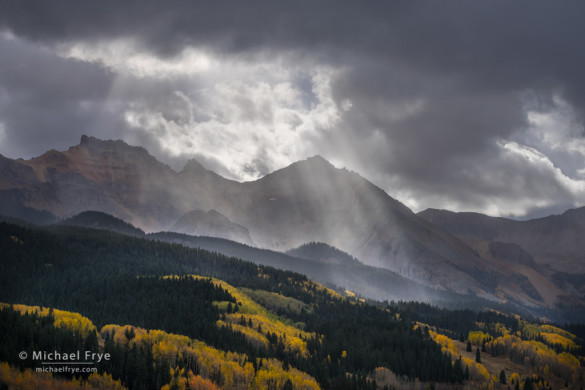
Sunbeams, San Juan Mountains, Colorado. Driving over Lizard Head Pass we came around a bend and spotted these sunbeams coming through the clouds. Claudia found a place to pull over, and I scrambled to set up my camera as quickly as possible. Wind was blowing rain right toward the camera, so it was a challenge to keep water drops off the lens. I stayed for at least 20 minutes capturing images of the sunbeams as they moved and changed, but this was the very first frame. A challenging photo to process!
With their straight, white trunks and colorful leaves, aspens are great subjects for intimate landscapes. But in both Colorado and the eastern Sierra this fall we had lots of interesting weather, with great clouds, which created many opportunities to capture images of aspens as part of a larger landscape, with mountains in the background. I’ve posted a couple of these photographs already (here and here), but I’ve included a few more in this post.
These images were sometimes challenging to process. Often the aspens were in the shade, with sunlit, sometimes snow-covered peaks above, creating a lot of contrast. Yet all of these images were processed in Lightroom, with just one Raw file – no exposure blending or HDR. I used Lightroom’s wonderful Highlights and Shadows tools, plus some dodging and burning with the Adjustment Brush.
With most high-contrast images, shadow areas can be left dark – maybe not completely black, but still looking like dark shadows, with perhaps a hint of detail. But when it’s important to show color in the shadows – when those shadows include colorful trees or flowers, for example – the shadows have to be lightened even more to show the color, and it can be difficult to do that in a natural-looking way. If you lighten the shadows too much you can eliminate the dark areas entirely, and without some dark tones there’s no contrast, leaving the image flat and lifeless. Too-light shadows can also just look weird and unnatural. But on the other hand, you have to lighten important colorful shadow areas enough to see the color, otherwise there’s no point in keeping that colorful foreground in the photograph. You have to strike the right balance, and try to make the shadows bright enough to show the color, but not too bright. I also think it helps if you don’t rely entirely on the Highlights and Shadows sliders, but also use Adjustment Brush to selectively lighten or darken parts of the frame.
In my next post I’ll go into more detail about processing these high-contrast, colorful images. In the meantime, I hope you enjoy this little portfolio. It was a lot of fun to capture these. It’s always great when the light, weather, and subject come together!
— Michael Frye
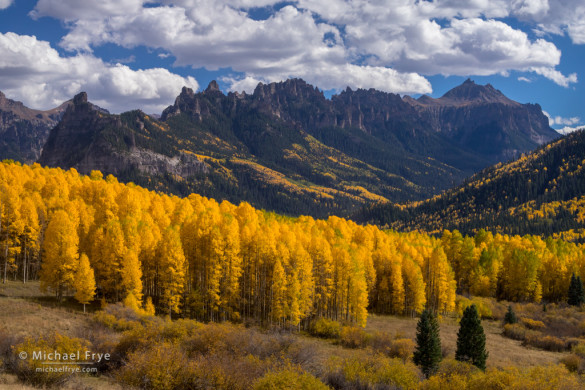
Aspens and Turret Ridge, Uncompahgre NF, Colorado. I liked the sunny-day, puffy-cloud feeling of this scene. Everything was in the sun in this mid-afternoon photograph, so there wasn’t much contrast, making this image relatively easy to process.
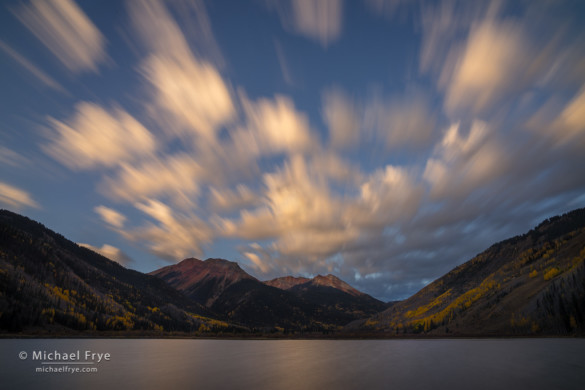
Fast-moving clouds at sunrise, Crystal Lake, Uncompahgre NF, Colorado. It was very windy on this morning, so I put on a neutral-density filter and made a 30-second exposure to smooth out the water. The blurred, fast-moving clouds looked really interesting, so I left the ND filter on and kept trying to capture that motion. I didn’t want to lighten the aspen-covered hillsides too much here, because I wanted to keep the viewers attention on the clouds.
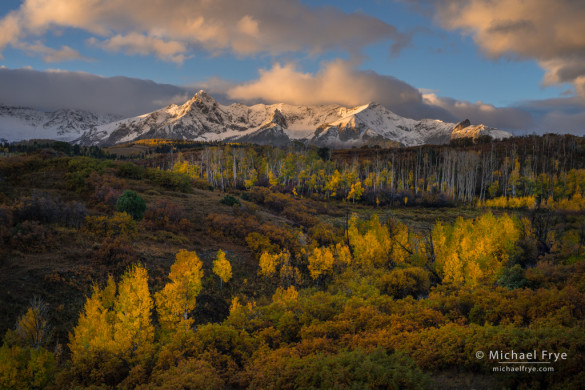
Autumn sunrise over the Sneffels Range from the Dallas Divide, Colorado. In autumn, this well-known spot can be as popular with photographers as Tunnel View. This was a gorgeous sunrise, with the sun breaking through the clouds to light the snowy mountains.
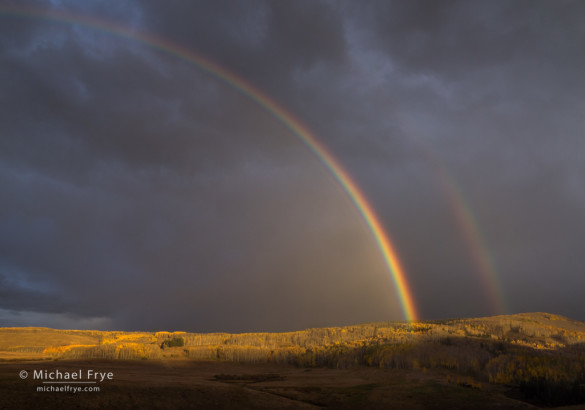
Double rainbow, Wilson Mesa, Colorado. Late in the afternoon a thunderstorm approached from the east, and the sun broke through clouds to create a double rainbow. Wind blew rain right toward the camera, so it was difficult to keep the lens dry, and I had to clone out some water spots in this frame. I expected to get dumped on at any moment, but luckily the heavy rain held off until I got back to the car.
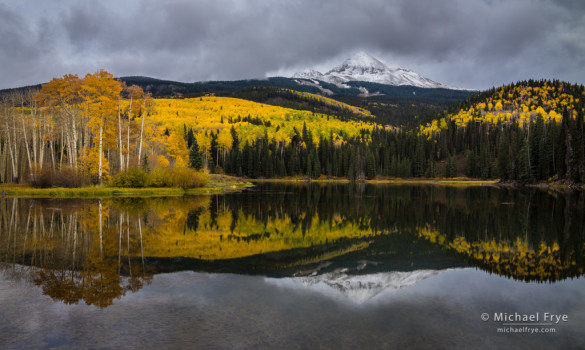
Aspens and reflections at a mountain lake, Uncompahgre NF, Colorado. We found this lake on our last afternoon in Colorado. We’ll have to go back!
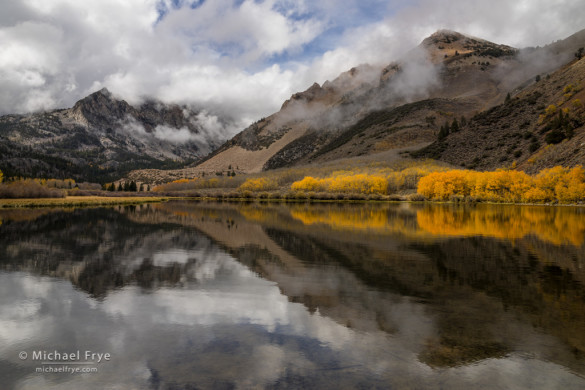
Clearing storm, autumn, North Lake, Inyo NF, California. During our first Eastern Sierra Fall Color workshop we photographed a wonderful clearing storm in Bishop Creek Canyon.
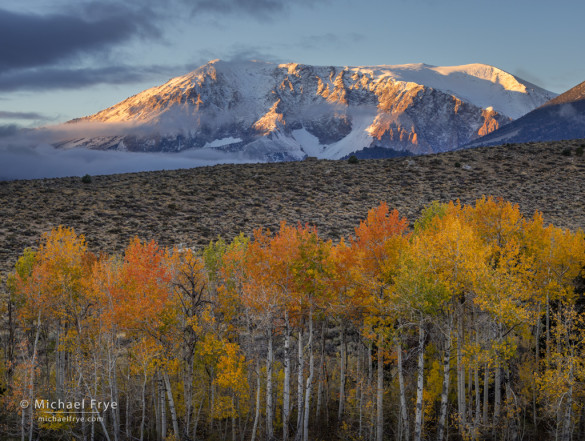
Aspens and peak at sunrise, Inyo NF, California. On the last morning of our second workshop we were treated to a beautiful sunrise, as the sun broke through clouds and mist to light freshly snow-covered peaks above an aspen grove.
Related Posts: From Eclipse to Aspens; Colorado Color; Eastern Sierra Fall Color Update
Did you like this article? Click here to subscribe to this blog and get every new post delivered right to your inbox!
Michael Frye is a professional photographer specializing in landscapes and nature. He is the author or principal photographer of The Photographer’s Guide to Yosemite, Yosemite Meditations, Yosemite Meditations for Women, Yosemite Meditations for Adventurers, and Digital Landscape Photography: In the Footsteps of Ansel Adams and the Great Masters. He has also written three eBooks: Light & Land: Landscapes in the Digital Darkroom, Exposure for Outdoor Photography, and Landscapes in Lightroom 5: The Essential Step-by-Step Guide. Michael has written numerous magazine articles on the art and technique of photography, and his images have been published in over thirty countries around the world. Michael has lived either in or near Yosemite National Park since 1983, currently residing just outside the park in Mariposa, California.







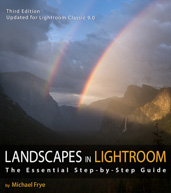
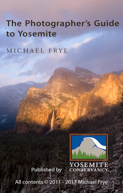
Very very nice photographs Michael. Happy fall color season Michael.
mARTin
Thank you Martin!
Very nice shots Michael. We have snow in the forecast for Tuesday here in Vernal, UT.
Marv
Thanks Marvin, and I hope you get some interesting weather there.
Those are terrific Michael. I really love what the clouds add. I missed the best of the clouds on my recent trip to the Eastern Sierra. But I did catch the incoming clouds on the 14th preceding the storm of the 15th.
https://johnchico.smugmug.com/Landscapes/Eastern-Sierra-Fall-2015/i-DdzcTkh/1/X3/JC-6799-l.jpg
Thanks John! You need a little luck to be in the right place at the right time for interesting clouds. I had little luck on that front last fall, but this year was better.
Don’t you love it when preparation meets opportunity (on a mountain trail) – fantastic Wow! M
Yes indeed Joseph – thanks!
Nice shots. Your timing was good to catch the snow in Colorado. I went home before that snow came through. Can you say what lake that was in Uncompaghre NF?
Thanks Patrick. That lake seems to off the radar of many Colorado photographers, so I’d rather not out it in a public forum.
Ok, I get that, I have that feeling too about some places I’ve been.
Such grand and glorious images. Really enjoy your emails and blog posts.
Thank you Terry!
Michael,
All of these images are breathtsking but my favorite is “Aspens and Turret Ridge”. I often photograph autumn aspens from late morning to mid-afternoon and find that these trees are very good subjects in what many consider harsh light. Also, that steel blue Colorado sky sets off a great color palate against the yellow and gold leaves. Since the sun has begun its southerly journey at that time of year, a polarizing filter is able to produce good sky and cloud contrast even during those hours. These are the times of day when most tourists and ” leaf peepers” drive the highways and byways to view the annual aspen change and so they can relate better to such photographs. Finally, many decades ago I was a student at Notre Dame whose school colors are “Gold on Blue” and those who have ever seen the Administration Building’s famed golden dome against the Indiana blue sky will be able to draw a parallel between that sight and a Colorado aspen autumn landscape.
Jim
Thanks Jim. For what it’s worth, I didn’t use a polarizer for that photo, but I get what you’re saying. Photos like that have a sunny-day feeling that people can relate to. Backlight helps a lot.
Gorgeous images, Michael. Captured beauty!
Thanks Greg!
Absolutely beautiful!!!!!!!!!!!!
Thanks Randy!
Michael, I really dig that you only used one frame to process these. I totally understand there are situations that require HDR processing, but I also like when a photographer shows that awesome shots can be created by only processing one frame. So kudos to you! These look great.
I looked back at some posts from a few years ago when you visited the Southern Appalachians during the fall. I enjoyed those very much! Should you and Claudia plan a trip this way for fall foliage (or for any other season) give me a shout! I’d be happy to make some recommendations for good spots.
Cheers,
Johnny
Johnny, thanks for your comments, and your offer to help with fall foliage locations in the southern Appalachians. We’d definitely like to head out there for fall one of these years.